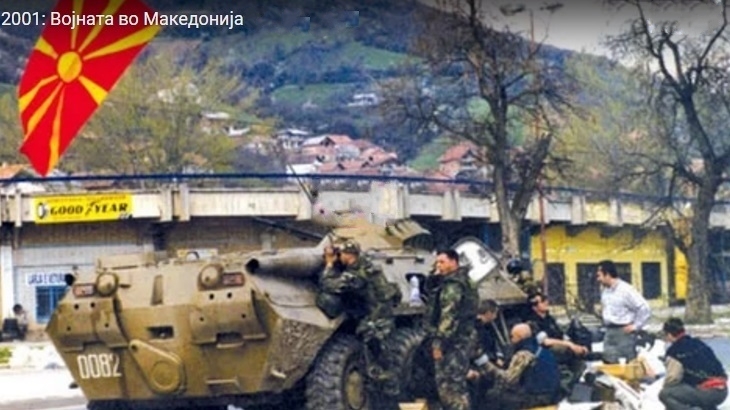Over the past couple of decades, a lot has happened in the Balkan region ranging from ethnic tension and small conflict to full-scale war. One nation that has traditionally dealt with fewer ethnic issues would be the Republic of Macedonia. Macedonia has long been considered the “Switzerland of the Balkans”, having been able to avoid bloodshed on its way to independence from Yugoslavia in 1991. In this role as the supposed land of peace, Macedonia has been the homeland of ethnic Macedonians and also served as a secure multicultural land for many other diverse ethnic groups, such as Albanians, but also Turks, Roma, Vlachs, and Serbs, among others. For a long time there have been minor conflicts between Macedonian-Albanians and ethnic Macedonians, but generally the two groups of people have had little trouble coexisting. Broadly speaking, these groups have both lived side-by-side for hundreds of years and have been able to look passed the ethnic and religious differences. Nonetheless, there have been cases where this peace has been challenged, especially between 1999-2001, when an overflow of Kosovo refugees entered Macedonia.
The 3-year span during 1999-2001 has undoubtedly played a large role in influencing the growth and stability of Macedonia today. However, to adequately assess what has happened in the country we must first uncover the root cause of ethnic tension. Let’s start with the late 1960’s, when ethnic clashes in Macedonia became more vivid. In November 1968, there were intense nationalistic uprisings taking place in Pristina, Kosovo (then part of Yugoslavia) leading up to Albanian Independence Day. These protests were a by-product of ethnic Albanian demands for increased autonomy in the years following WWII. Just a month later, the same types of riots took place in Tetovo (a city in northwest Macedonia), and it appeared that Macedonian-Albanians had followed the trend of their neighbors in Kosovo. However, this chain of events is a bit more complicated than it appears. One prominent professor of Turkish studies, Isa Blumi, makes the intriguing argument that these protesters in Tetovo were actually Kosovar Albanians who fled Pristina after fierce suppression from Yugoslavian armed forces—this would explain where unrest within Macedonian territory stems. Other established scholars from the region have shared similar sentiment, implying that the ethnic issues in Macedonia have long been associated with instability in Kosovo. Biljana Vankovska-Cvetkovska, a well-known professor at the University of Skopje sums it up best in her 1999 article, stating, “One can notice that almost every tension in Macedonia has been a reflection of the influx of Kosovo activists rather than a result of an authentic activism of Macedonia’s ethnic Albanians.” It is crucial to understand this because it exposes the often-forgotten reality of the situation: Macedonian-Albanians were not inherently anti-Macedonian and never really were, but they have frequently been influenced directly and indirectly by the Kosovars over the past several decades.

Now, let us fast-forward to 1981, where this situation grew more complicated. One common misnomer is the perception that the Albanian minority in Macedonia has not had proper rights—and this is simply untrue. A fairer evaluation would acknowledge that Albanians were somewhat underrepresented in political and economic institutions in the early 1980’s, which is certainly something that needed to be addressed. However, to surmise that this alone would create a basis for ethnic conflict in Macedonia would be a major overstatement, especially given the fact that Macedonian-Albanians have traditionally been seen as one of the better-treated minorities in all of the Balkans. Moreover, there are many other minorities that have had more constrained representation in the Macedonian government but violent measures were never taken because of it. In other words, there are dozens of nations all over the world that have had issues incorporating an appropriate proportion of minorities into political and economic sectors, and this often leads to a degree of political discourse—but never a full-scale insurgency such as the one in Macedonia during 2001. Now that the foundation of this discussion has been laid, we are able take a closer look at the infamous conflict itself and where it began.
Prior to 1999, there were major clashes taking place in neighboring Kosovo between the Kosovar Albanians and Serbian government, under the watch of Slobodan Milosevic. The Serbian government, in an effort to express its control over the territory of Kosovo, killed thousands of Kosovars, prompting international intervention. NATO, in 1999, decided the best course of action was to evacuate huge groups of ethnic Albanians from Kosovo and let them seek refuge elsewhere— primarily in Macedonia and Albania. This was problematic for a couple of reasons. Firstly, because NATO sent over 360,000 ethnic Albanian refugees from Kosovo into Macedonia, a country of just 2 million people. It is interesting to note that there was immense international pressure on the young country to undertake these refugees, with the understanding that many of them were supposed to be heading towards Albania proper. The whole operation put a major strain on the Macedonian people and government, having undertaken a large group of refugees that amounted to approximately 15% of its total population. To put this into perspective, imagine the United States taking in 50 million refugees from Mexico; the problems that it would cause the citizens and government are inconceivable. It is highly unlikely that the United States would take in so many refugees, but that’s precisely the ratio of migrants Macedonia was taking relative to its population in 1999 during the Kosovo conflict.

Aside from this major misstep by NATO and many western powers, greater concerns exist when it comes to Macedonia’s well-being. An even bigger issue is the constant reference from mainstream global media describing the 2001 conflict as being a near “civil war”. What took place on Macedonian land in 2001 was terrorism at its worst. The extremists of the Kosovo Liberation Army (or KLA), led by Ali Ahmeti, had a chief goal of taking over the western territory of Macedonia and dividing the state. The dream of these radical guerrilla fighters was to create a “Greater Albania”. One of Ahmeti’s commanders explicitly said this after the conflict ended, stating, “like all wars, ours was for territory–not because of some “human rights” problem!”. This is what the west does not seem to understand (or chooses not to understand)–the fight in 2001 was not for “greater rights” on behalf of Macedonian-Albanians, but was a legitimate attempt to destabilize the country and take over the predominantly Albanian western territory. Just because there was violence done upon the people of Kosovo by the Serbian government, this does not and should not permit ethnic Albanian extremists to attack and terrorize a nation that did nothing to provoke such violence. It is at this juncture where the international community failed by taking a deplorably soft approach post-2001 when dealing with these terrorists, an approach that has not helped the situation in the slightest. For this reason, it is imperative that the rest of the world takes a closer look at the situation in Macedonia from a different vantage point.
One thing that will inevitably not be forgotten by the people of Macedonia is what became of the KLA terrorists—thanks to the Ohrid Framework Agreement and international pressure for peace the vast majority of them were granted amnesty. Several of these same KLA extremists (i.e Ali Ahmeti, Talat Xhaferi) who attempted to destroy the unity of the Macedonian homeland and instill fear amongst its citizens now possess power in some of the most influential political offices. In the vast majority of democracies around the world, it is doubtful that such criminals would even be granted forgiveness let alone serve the people of the country they tried to demolish. Having allowed these kinds of guerrilla fighters the right to serve in the domestic government has only incited violence and created unnecessary ethnic hatred amongst Macedonians and Albanians.

When it comes to relations with Kosovo since their independence, Macedonia has been a great ally. The country has practiced good neighborly relations on countless instances: Macedonia welcomed a large amount of Kosovo refugees during 1999, recognized Kosovo knowing that it would severely hinder relations with Serbia, supported Kosovo’s UNESCO membership, and consistently helped Kosovo have a seat at the table. Macedonia has served as Kosovo’s top supporter in the Balkans after Albania. One recent development that has caused instability and brought further resentment from the Macedonian people and government is interference in Macedonia’s internal affairs by Edi Rama, Albania’s Prime Minister. Prior to Macedonian parliamentary elections, Rama invited the main Albanian parties in Macedonia to attend a meeting in Tirana to discuss a joint political platform for all Albanians. This is a clear overstep by Rama and it can only breed further instability in Macedonia—Edi Rama does not have the right to exert influence on a foreign nation. Other provocations have come from Hashim Thaci, the President of Kosovo. He has harshly criticized the actions of President Gjorge Ivanov, who refused to grant the government mandate to SDSM and its coalition with three Albanian parties. It is these types of provocations that make it challenging to maintain ethnic cohesion within Macedonia.
With all factors considered, the main takeaway here is this: NATO and other western powers were the largest culprits of this conflict and its aftereffects, because they put groups of people into a place and situation that was ripe for violence to break out. Knowing the history and vulnerability in allowing Kosovars to flood into Macedonia should have immediately deterred them from implementing this plan. In the end, the ones who have suffered most are Macedonian citizens of all backgrounds, and the effects of this are still felt today—people and government have both become more polarized than ever, creating a highly unstable and increasingly nationalistic atmosphere.
—
The views of the author may not necessarily reflect the views of the United Macedonian Diaspora and Generation M.

